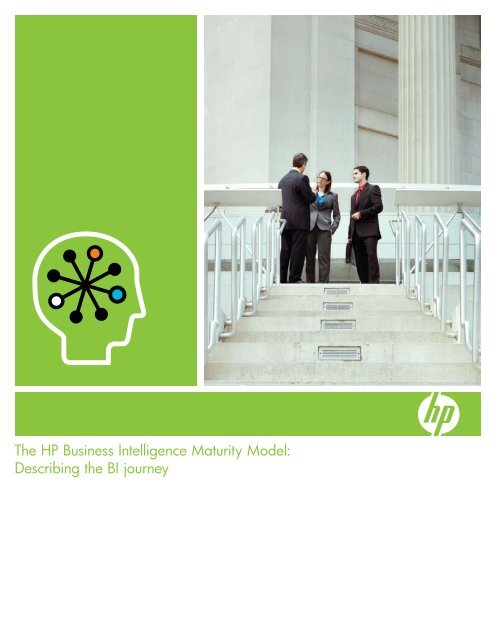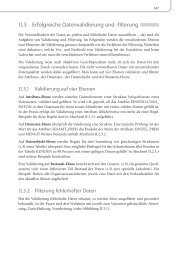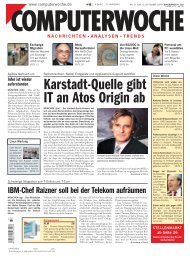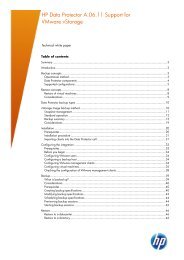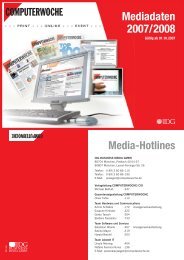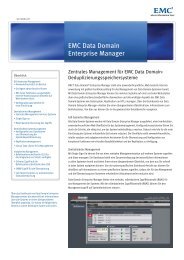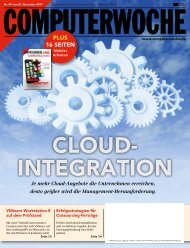The HP Business Intelligence Maturity Model: Describing the BI ...
The HP Business Intelligence Maturity Model: Describing the BI ...
The HP Business Intelligence Maturity Model: Describing the BI ...
Create successful ePaper yourself
Turn your PDF publications into a flip-book with our unique Google optimized e-Paper software.
<strong>The</strong> <strong>HP</strong> <strong>Business</strong> <strong>Intelligence</strong> <strong>Maturity</strong> <strong>Model</strong>:<br />
<strong>Describing</strong> <strong>the</strong> <strong>BI</strong> journey
Table of contents<br />
A winning formula for <strong>BI</strong> success . . . . . . . . . . . . . . . . . . . . . . . . . . . . . . . . . . . . . . . . . . . . . . . . . . . . . 3<br />
Stage 1: Running <strong>the</strong> business ....................................................... 3<br />
Stage 2: Measuring and monitoring <strong>the</strong> business .......................................... 4<br />
Stage 3: Integrating performance management and intelligence ............................... 5<br />
Stage 4: Fostering business innovation and people productivity ................................ 6<br />
Stage 5: Creating strategic agility and differentiation ...................................... 7<br />
Conclusion .................................................................... 7<br />
For more information ............................................................. 7
<strong>BI</strong> <strong>Maturity</strong> <strong>Model</strong><br />
<strong>Business</strong> Enablement<br />
Creating strategic agility<br />
and differentiation<br />
Foresight<br />
Fostering business innovation<br />
and people productivity<br />
Knowledge<br />
Integrating performance<br />
management and intelligence<br />
Insight<br />
Measuring and monitoring<br />
<strong>the</strong> business<br />
Information<br />
Running <strong>the</strong> business<br />
Facts and data<br />
Stage 1<br />
Operation<br />
Project<br />
Activity<br />
Ad Hoc<br />
Solutions<br />
A winning formula for <strong>BI</strong> success<br />
Stage 2<br />
Improvement<br />
Project Project<br />
Mgmt. Mgmt.<br />
Localized<br />
Solutions<br />
For well over a decade, companies have invested in<br />
a variety of business and IT initiatives that strive to<br />
improve decision-making and intelligence capabilities.<br />
As a result, <strong>the</strong>y have a rich set of building blocks to<br />
leverage as <strong>the</strong>y work toward a more integrated, agile<br />
business intelligence environment. Understanding how<br />
to leverage <strong>the</strong>ir <strong>BI</strong> investments fully while evolving to<br />
<strong>the</strong> next level of maturity can, however, be difficult.<br />
A <strong>BI</strong> maturity model can be invaluable in this process<br />
as it outlines a path forward and helps companies<br />
work toward closer alignment of <strong>the</strong>ir business and<br />
IT organizations.<br />
<strong>HP</strong> has developed a <strong>BI</strong> <strong>Maturity</strong> <strong>Model</strong> as a<br />
context for describing <strong>the</strong> evolution of our clients’ <strong>BI</strong><br />
capabilities. <strong>The</strong> model is based on our experiences<br />
with clients across a wide range of industries. It<br />
represents a formula for success that is a function of<br />
three capabilities: business enablement, information<br />
technology, and strategy and program management.<br />
<strong>The</strong> business enablement dimension describes <strong>the</strong><br />
advancing nature of <strong>the</strong> types of business needs and<br />
problems that are solved with <strong>BI</strong> solutions.<br />
<strong>The</strong> information technology dimension describes<br />
<strong>the</strong> advancing nature of <strong>the</strong> information solutions a<br />
company adopts to serve a variety of business needs.<br />
Stage 3<br />
Alignment<br />
Program Program<br />
Mgmt. Mgmt. and and<br />
Governance Governance<br />
Shared<br />
Resources<br />
Stage 4<br />
Empowerment<br />
Portfolio<br />
Mgmt.<br />
Enterprise<br />
Operationalized<br />
Stage 5<br />
Transformation<br />
Service<br />
Mgmt.<br />
Enterprise<br />
Services<br />
Strategy Stra Strategy and<br />
Prog Program<br />
Mana Management<br />
Information<br />
Technology<br />
<strong>The</strong> strategy and program management dimension<br />
describes <strong>the</strong> advancing nature of management skill<br />
as a key enabler and catalyst for <strong>BI</strong> success.<br />
In this white paper, we look at <strong>the</strong> characteristics of<br />
companies in each stage of <strong>the</strong> <strong>BI</strong> journey across<br />
<strong>the</strong>se three dimensions. We also describe <strong>the</strong> steps<br />
companies must take to advance <strong>the</strong>ir capabilities<br />
from one level to <strong>the</strong> next.<br />
Stage 1: Running <strong>the</strong> business<br />
Many organizations are still in <strong>the</strong> early stages of<br />
making core <strong>BI</strong> investments. <strong>The</strong>se might include new<br />
companies that are just beginning to think about<br />
<strong>BI</strong>, but might also encompass organizations that<br />
have already been through several false starts with<br />
<strong>BI</strong> and are revisiting <strong>the</strong>ir basic <strong>BI</strong> strategy. This is<br />
<strong>the</strong> beginning stage in which frameworks are being<br />
laid and concepts are being formed, often at <strong>the</strong><br />
departmental or local level within an enterprise. In<br />
Stage 1, <strong>BI</strong> is necessary to pull in facts and data as<br />
needed to simply run <strong>the</strong> business.<br />
<strong>Business</strong> enablement in Stage 1: <strong>Business</strong> needs are<br />
focused on <strong>the</strong> enhancement of basic reporting and<br />
analysis capabilities, with spreadsheets often used<br />
as <strong>the</strong> <strong>BI</strong> tool of choice. <strong>BI</strong> consumers are mostly<br />
concentrated among executives and managers,<br />
with a small group of analysts or operations users<br />
3
doing <strong>the</strong> manual work of pulling toge<strong>the</strong>r data<br />
from various sources and creating basic reports<br />
and analyses to feed to management. Reports and<br />
analyses are mostly provided on a quarterly or<br />
monthly basis, <strong>the</strong>re is little capacity to deliver lower<br />
levels of information latency. Projects in <strong>the</strong> areas of<br />
finance, marketing, or sales reporting can often be<br />
successfully deployed at this stage. An example of<br />
<strong>the</strong>se types of projects would include departmental<br />
financial reporting, local or regional sales history,<br />
and some level of sales forecasting.<br />
Information technology in Stage 1: Information<br />
technology solutions in Stage 1 focus on gaining<br />
basic access to data. <strong>The</strong>se are often local, ad<br />
hoc efforts focused on meeting local demand.<br />
Data is housed in department or business-function<br />
data marts, or even within specific applications. <strong>The</strong>re<br />
is no cross-department or cross-function integration<br />
of data repositories. Stage 1 is characterized by<br />
early efforts in ETL (extract, transform, load), data<br />
warehousing, and OLAP (online analytical processing).<br />
Most solutions involve a high degree of manual<br />
effort to ga<strong>the</strong>r data, integrate it, and prepare it for<br />
presentation in a report.<br />
Strategy and program management in Stage 1:<br />
Project activity is localized in this stage, with limited<br />
focus on project management as a discipline. Projects<br />
are small in scale and mostly intra departmental. C-level<br />
involvement in <strong>BI</strong> investment decisions is extremely<br />
limited or non-existent. <strong>BI</strong> expertise is concentrated<br />
within a small group of individuals in <strong>the</strong> organization.<br />
Moving to Stage 2: One key step in evolving to Stage<br />
2 is improving access to data at a departmental or<br />
functional level. In Stage 1, data might be housed in<br />
disparate databases or applications, even within a<br />
single department or group. Companies should work<br />
on integrating <strong>the</strong>se data repositories for one subject<br />
area or domain at a time. Ano<strong>the</strong>r important step<br />
to tackle at this stage is understanding both current<br />
and future needs for <strong>BI</strong> skill sets. <strong>BI</strong> talent in Stage 1<br />
companies is typically concentrated in a small pool<br />
of individuals, but moving to Stage 2 and beyond<br />
requires a broader base of <strong>BI</strong> talent. Companies who<br />
begin identifying <strong>the</strong>ir resource requirements early<br />
have an easier time evolving <strong>the</strong>ir <strong>BI</strong> projects and<br />
programs. Finally, companies in Stage 1 should work<br />
on obtaining management buy-in for <strong>BI</strong> efforts. <strong>The</strong><br />
visibility that management support brings, opens <strong>the</strong><br />
door for investments in both manpower and capital.<br />
Stage 2: Measuring and monitoring<br />
<strong>the</strong> business<br />
In Stage 2, <strong>BI</strong> efforts are focused on localized subject<br />
area or vertical solutions, such as implementing HR<br />
analytics or beginning to integrate customer data. At<br />
this stage, manual, ad-hoc solutions give way to more<br />
planned strategies of how to not only measure what is<br />
happening with <strong>the</strong> business, but also how to monitor<br />
it and provide a level of visibility for management to<br />
use in a more timely manner.<br />
<strong>Business</strong> enablement in Stage 2: <strong>Business</strong> needs<br />
are still focused on enhancing reporting and<br />
analysis capabilities, but are also moving into <strong>the</strong><br />
implementation of basic dashboards and scorecards,<br />
and even some planning, budgeting and forecasting<br />
applications. <strong>BI</strong> consumers are still mostly concentrated<br />
at <strong>the</strong> executive and management level, but <strong>the</strong>re is<br />
less manual effort involved in preparing and presenting<br />
<strong>the</strong> data. Users are able to take advantage of some<br />
self-service <strong>BI</strong> capabilities and might even be able to<br />
customize some reports or analyses on a limited basis.<br />
Information latency is decreasing, with reports and<br />
analysis delivered on a weekly or monthly basis.<br />
Information technology in Stage 2: Information<br />
technology solutions in Stage 2 are characterized by<br />
a focus on serving <strong>the</strong> needs of specific subject areas<br />
of information. Vertical data warehouses, data mart,<br />
and operational data stores are commonplace. <strong>The</strong>se<br />
data repositories might be leveraged by multiple<br />
departments or business units, but <strong>the</strong>y each remain<br />
focused on a single subject area with no integration<br />
between <strong>the</strong>m. Organizations in Stage 2 are moving<br />
into Web-based reporting applications and are<br />
increasingly taking advantage of <strong>the</strong> <strong>BI</strong> capabilities<br />
offered through <strong>the</strong>ir ERP vendors. Data quality is<br />
becoming more important, but efforts in this area are<br />
largely ad hoc and manual, involving mostly basic<br />
ETL-based cleansing.<br />
Strategy and program management in Stage 2:<br />
Organizations in Stage 2 have begun to recognize<br />
<strong>the</strong> criticality of project management as a discipline<br />
that manages scope, mitigates risks, and manages<br />
costs. Project-based roles and skills for <strong>BI</strong> are formally<br />
identified, and <strong>BI</strong> project managers have interdepartmental<br />
responsibilities. Although companies<br />
at this stage are becoming more sophisticated<br />
at identifying <strong>the</strong> business benefits of <strong>the</strong>ir <strong>BI</strong><br />
investments, C-level involvement in <strong>BI</strong> decisions<br />
remains limited. However, <strong>the</strong>re may be pockets<br />
of support and heightened interest among savvy<br />
executives and managers.<br />
4
Moving to Stage 3: In Stage 2, reports and<br />
analyses are usually delivered on a monthly or weekly<br />
basis, but evolving to Stage 3 requires a move to<br />
right-time information delivery. A company in Stage 2<br />
would, <strong>the</strong>refore, be wise to begin documenting <strong>the</strong><br />
information delivery needs of its <strong>BI</strong> consumers so<br />
that it is able to define exactly what right time means<br />
for each of its user groups. Documenting user needs<br />
also comes in handy for evolving and optimizing<br />
<strong>the</strong> types of reporting and analytical tools provided<br />
to <strong>BI</strong> consumers. Stage 3 also marks <strong>the</strong> beginning<br />
of more sophisticated data quality and governance<br />
efforts. Companies in Stage 2 should begin to identify<br />
those business departments or groups that have a<br />
commitment to taking ownership of <strong>the</strong>ir data and<br />
that could serve as ideal proving grounds for more<br />
sophisticated data quality and governance programs.<br />
Finally, a key characteristic of a Stage 3 company<br />
is <strong>the</strong> presence of a <strong>BI</strong> vision and roadmap. Stage 2<br />
enterprises should evaluate whe<strong>the</strong>r <strong>the</strong>y have <strong>the</strong><br />
in-house resources and know-how to develop <strong>the</strong>se<br />
assets, or if <strong>the</strong>y should seek assistance from an<br />
outside consulting partner.<br />
Stage 3: Integrating performance<br />
management and intelligence<br />
Companies in Stage 3 are beginning to achieve an<br />
integrated view of <strong>the</strong> subject- or vertical-oriented<br />
information solutions <strong>the</strong>y implemented in Stage 2.<br />
This integration enables increased business value<br />
through more complex metrics and analyses. For<br />
example, organizations in Stage 3 can begin to<br />
calculate metrics like customer profitability, which<br />
requires data from both <strong>the</strong> customer and financial<br />
domains. At this Stage, <strong>the</strong> business value of <strong>BI</strong><br />
begins to be realized. Metrics are defined, processes<br />
are in place and much of <strong>the</strong> thought processes that<br />
went into Stage 2 start to come toge<strong>the</strong>r into a set of<br />
assets and capabilities that directly target business<br />
improvement through broad-based use of <strong>BI</strong>.<br />
<strong>Business</strong> enablement in Stage 3: Once localized<br />
reporting needs have been satisfied in Stage 2, <strong>the</strong><br />
business drivers turn to a higher degree of alignment<br />
and integration, usually described by a linkage<br />
with a broader business performance management<br />
agenda within <strong>the</strong> organization. At this point, <strong>the</strong>re<br />
is a heightened focus on <strong>the</strong> value of analytics, often<br />
embedded within o<strong>the</strong>r systems or business workflows.<br />
Companies have implemented integrated reporting<br />
and are moving towards balanced scorecards<br />
and streamlined key performance indicators. <strong>BI</strong><br />
consumers are expanding to include more frontline<br />
employees, not just executives and management.<br />
<strong>The</strong> availability of data is also more consistent<br />
and instead of being defined by potential system<br />
constraints, data is now delivered when needed<br />
(at <strong>the</strong> right time) and pulled, cleansed and used<br />
according to <strong>the</strong> business needs.<br />
Information technology in Stage 3: Information<br />
integration across subject areas and across business<br />
unit solutions is key in this stage. Standalone data<br />
warehouses and marts are consolidated and an<br />
enterprise or centralized data warehouse is likely<br />
in <strong>the</strong> works. In Stage 3, companies are beginning<br />
early master data management efforts to achieve a<br />
single view of one or two key reference data domains,<br />
including customers, suppliers, and employees. Data<br />
quality and data governance efforts also become<br />
more important and more sophisticated at this stage.<br />
Specific business areas have taken ownership of <strong>the</strong>ir<br />
data and have identified data stewards.<br />
Strategy and program management in Stage 3:<br />
As business needs advance and information solutions<br />
reach higher levels of integration, management skills<br />
become critical to success. Stakeholder management<br />
(such as governance), resource management (such<br />
as outsourcing), and change management (such as<br />
competency centers) become key skills to facilitate<br />
heightened levels of integration. In Stage 3,<br />
organizations have evolved from <strong>BI</strong> project<br />
management to <strong>BI</strong> program management and<br />
have a <strong>BI</strong> vision and roadmap in place, business<br />
case discipline, a governance model, and a risk<br />
management methodology. <strong>BI</strong> competency centers<br />
(<strong>BI</strong>CCs) begin to evolve at this stage, along with<br />
early leverage of a three-tier delivery model to<br />
optimize costs and resources. At this point, C-level<br />
management is normally enthusiastically engaged<br />
in <strong>BI</strong>, as <strong>the</strong>y realize <strong>the</strong> quantitative impact on <strong>the</strong><br />
business, often resulting in cost savings.<br />
Moving to Stage 4: Empowering frontline users is a key<br />
focus of Stage 4. In Stage 3, executives, management,<br />
and a select group of power users likely comprise<br />
<strong>the</strong> vast majority of <strong>the</strong> organization’s <strong>BI</strong> user base.<br />
Expanding <strong>BI</strong> to “<strong>the</strong> masses” is a big requirement for<br />
moving to Stage 4. Companies in Stage 3 need to<br />
understand <strong>the</strong> requirements of a whole new group of<br />
users and <strong>the</strong> types of technologies (such as activity<br />
monitoring) that can meet <strong>the</strong>ir needs for operational<br />
information. Unstructured content also enters <strong>the</strong><br />
picture in Stage 4. Companies in Stage 3 should<br />
start to map out <strong>the</strong>ir unstructured information assets<br />
and understand how those assets can combine with<br />
structured data to enable more powerful analysis and<br />
guidance for both management and frontline users.<br />
5
Stage 4: Fostering business<br />
innovation and people productivity<br />
Companies at Stage 4 in <strong>BI</strong> are turning information<br />
into a very powerful asset. <strong>The</strong>y are meeting <strong>the</strong><br />
challenges surrounding master data management,<br />
data governance, and bringing <strong>BI</strong> to <strong>the</strong> masses.<br />
<strong>Business</strong>-specific analytics are now a key component<br />
of business strategy and are embedded into business<br />
processes. Information is available when it is needed,<br />
where it is needed. Information is centralized and<br />
<strong>the</strong> environment is flexible and can easily adapt to<br />
changes in business questions.<br />
<strong>Business</strong> enablement in Stage 4: Stage 4 is<br />
characterized by <strong>the</strong> leveraging of intelligence to<br />
transform <strong>the</strong> way business processes are designed<br />
and <strong>the</strong> way people work. Analytics are automated<br />
and embedded into business processes to enable<br />
frontline decision-making. Frontline users have<br />
new expectations around information delivery and<br />
capabilities that allow <strong>the</strong>m to be more responsive<br />
to <strong>the</strong>ir business environments, predict outcomes,<br />
and dig deeper with analytics. Activity monitoring<br />
and o<strong>the</strong>r forms of operational <strong>BI</strong> that are typically<br />
adopted in Stage 4 also become a catalyst for<br />
generating even more demand for <strong>BI</strong> among “<strong>the</strong><br />
masses.” Although frontline workers receive increased<br />
focus as <strong>BI</strong> users in Stage 4, executives and managers<br />
also embrace <strong>BI</strong> and continue to use it to set and<br />
manage corporate strategy.<br />
Information technology in Stage 4: In Stage 4, <strong>the</strong><br />
enterprise reconciles to create a single version of<br />
<strong>the</strong> truth across <strong>the</strong> organization. Companies in<br />
Stage 4 are tackling more advanced master data<br />
management that addresses multiple business<br />
domains and/or geographies. <strong>The</strong> data governance<br />
program has <strong>the</strong> support of senior IT and business<br />
stakeholders and is able to enforce standards and<br />
policies across <strong>the</strong> organization. A robust data<br />
quality program is in place, and business and IT<br />
stakeholders have a commitment to addressing data<br />
quality problems at <strong>the</strong> source ra<strong>the</strong>r than using<br />
downstream cleansing to “mask” data quality issues.<br />
Efforts are underway to integrate unstructured content<br />
with structured data to enable worker productivity.<br />
<strong>BI</strong> is fully integrated within <strong>the</strong> enterprise portal<br />
environment, and <strong>the</strong> organization is beginning to<br />
implement advanced analytic technologies like data<br />
visualization to meet <strong>the</strong> needs of users.<br />
Strategy and program management in Stage 4:<br />
In Stage 4, portfolio management becomes of higher<br />
importance as <strong>BI</strong> becomes a natural component to<br />
all strategic initiatives. <strong>The</strong> <strong>BI</strong> program management<br />
office (PMO) is integrated within <strong>the</strong> organization’s<br />
broader strategic PMO. <strong>BI</strong> portfolio managers are<br />
in place, and <strong>the</strong> organization is taking advantage<br />
of a robust, flexible resource delivery model. <strong>The</strong><br />
company has an advanced governance model for<br />
<strong>BI</strong> and a sophisticated approach for identifying and<br />
realizing <strong>the</strong> business benefits of <strong>BI</strong> programs. <strong>The</strong>re<br />
is C-level sponsorship of <strong>the</strong> <strong>BI</strong> portfolio, enabling <strong>BI</strong><br />
to be interwoven into all of <strong>the</strong> company’s most critical<br />
activities and programs.<br />
Moving to Stage 5: Movement to Stage 5 requires<br />
work on streamlining <strong>BI</strong> processes and procedures<br />
by establishing a service-oriented framework for <strong>the</strong><br />
delivery of all <strong>BI</strong>. Companies in Stage 4 should begin<br />
exploring how service-oriented architecture (SOA)<br />
can enable seamless integration and delivery of data<br />
across <strong>the</strong> enterprise. Organizations that want to move<br />
6
to Stage 5 must also work on <strong>the</strong> speed with which<br />
<strong>the</strong>y are able to deliver new analytics to users as<br />
well as on understanding how emerging technologies<br />
affect <strong>the</strong> way users receive and process information.<br />
Finally, <strong>the</strong> move from Stage 4 to Stage 5 requires<br />
not just C-level sponsorship of <strong>the</strong> <strong>BI</strong> portfolio, but<br />
C-level commitment to embracing <strong>BI</strong> as a strategic<br />
lever for <strong>the</strong> business. Companies in Stage 4 should<br />
assess <strong>the</strong> readiness of <strong>the</strong>ir C-suite executives for this<br />
evolution and determine <strong>the</strong> change management and<br />
education initiatives required to make it happen.<br />
Stage 5: Creating strategic agility<br />
and differentiation<br />
Very few, if any, enterprises are truly at Stage 5 in<br />
all segments of <strong>the</strong>ir business model. This is <strong>the</strong> final<br />
stage where <strong>BI</strong> is built into <strong>the</strong> very fabric of every<br />
level of an organization, and predictive analytics are<br />
used across <strong>the</strong> board for most business decisions.<br />
Talk of service level agreements (SLAs), batch windows<br />
and user buy-in is long-past, and a fully-functional<br />
approach based on a service-oriented architecture<br />
allows for business model flexibility through true<br />
information agility. Systems, users, and tools are<br />
integrated, and are providing guidance, support, and<br />
leverage for <strong>the</strong> <strong>BI</strong> portfolio.<br />
<strong>Business</strong> enablement in Stage 5: In Stage 5, <strong>the</strong><br />
organization benefits from an agile information<br />
environment, in which information no longer prohibits<br />
strategic agility but promotes and enables it.<br />
Systemic, dynamic business modeling for competitive<br />
advantage becomes a reality. Analytics are seen as<br />
a key differentiator for <strong>the</strong> organization, not just as a<br />
value-adding activity. <strong>BI</strong> innovation becomes a core<br />
<strong>the</strong>me in <strong>the</strong> organization’s R&D investment portfolio.<br />
<strong>The</strong> benefits from highly integrated, syn<strong>the</strong>sized<br />
information and intelligence are widespread, and<br />
users at all levels of <strong>the</strong> organization have access to<br />
insights that help <strong>the</strong>m to work more effectively and<br />
optimize business outcomes.<br />
Information technology in Stage 5: In Stage 5,<br />
information management capabilities reach <strong>the</strong>ir<br />
highest level, wherein information is delivered via a<br />
service model. Integrated information is available<br />
seamlessly without regard to data source or integration<br />
technology used. Data governance and quality<br />
programs continue in full force, supported by C-level<br />
sponsorship and a pervasive belief in business<br />
ownership of <strong>the</strong> data and <strong>the</strong> importance of correcting<br />
data quality problems at <strong>the</strong>ir source. Unstructured<br />
and structured data are fully integrated. Advanced<br />
<strong>BI</strong> is fully embedded within processes, systems, and<br />
workflow. Information delivery efforts are characterized<br />
by agility, and new analytics are easily developed for<br />
new roles. Users are able to access <strong>the</strong> information<br />
<strong>the</strong>y need, when <strong>the</strong>y need it, delivered in a way that<br />
seamlessly supports <strong>the</strong>ir role in <strong>the</strong> organization.<br />
Strategy and program management in Stage 5:<br />
Stage 5 is characterized by <strong>the</strong> realization of <strong>the</strong><br />
full business value of <strong>BI</strong>. <strong>The</strong> C-level embraces <strong>BI</strong> as<br />
a lever for strategic change. A new role of Chief<br />
Analytics Officer might even emerge at this stage to<br />
guide <strong>the</strong> organization in using its information assets<br />
to outmaneuver <strong>the</strong> competition. Advanced <strong>BI</strong> portfolio<br />
management helps <strong>the</strong> organization achieve <strong>the</strong> full<br />
strategic value of its <strong>BI</strong> investments, and <strong>the</strong> company<br />
has a commitment to include <strong>BI</strong> on <strong>the</strong> agenda of its<br />
R&D organization.<br />
What’s next for companies in Stage 5: Once an<br />
organization reaches Stage 5 it must continue to<br />
evolve its <strong>BI</strong> capabilities by understanding and<br />
leveraging new technologies. This encompasses<br />
not only <strong>the</strong> next wave of innovation in information<br />
delivery from <strong>BI</strong> vendors, but also <strong>the</strong> new devices<br />
and technologies that have become a part of <strong>the</strong> way<br />
users work every day. Organizations in Stage 5 may<br />
also face challenges related to globalization. <strong>The</strong>ir<br />
<strong>BI</strong> portfolios must be able to adapt to geographical<br />
differences, whe<strong>the</strong>r in terms of data formats, sources,<br />
collection methods, privacy regulations or preferred<br />
methods for receiving and using intelligence. Reaching<br />
Stage 5 is an achievement in itself, but <strong>the</strong> exceptional<br />
organization that does so cannot afford to rest on its<br />
laurels. It must embrace an ongoing commitment to <strong>BI</strong><br />
innovation and to ensuring that <strong>the</strong> information needs<br />
of users at all levels of <strong>the</strong> organization are met.<br />
Conclusion<br />
<strong>The</strong> <strong>HP</strong> <strong>BI</strong> <strong>Maturity</strong> <strong>Model</strong> describes <strong>the</strong> path forward<br />
as companies work toward closer alignment of business<br />
and IT organizations. It is evident that <strong>the</strong> industry is<br />
maturing steadily, as Stage 3 topics like governance<br />
and master data management are common hot topics<br />
at leading conferences and in company boardrooms.<br />
<strong>The</strong> model also highlights a critical emerging need for<br />
a new breed of talent and leadership, namely program<br />
managers, business architects, and information<br />
architects, that can guide <strong>the</strong> next generation of<br />
integrated, high-value <strong>BI</strong> solutions.<br />
For more information<br />
For more information, visit www.hp.com/go/bi<br />
7
Technology for better business outcomes<br />
To learn more, visit www.hp.com/go/bi<br />
© Copyright 2007, 2009 Hewlett-Packard Development Company, L.P. <strong>The</strong> information contained herein<br />
is subject to change without notice. <strong>The</strong> only warranties for <strong>HP</strong> products and services are set forth in <strong>the</strong><br />
express warranty statements accompanying such products and services. Nothing herein should be construed<br />
as constituting an additional warranty. <strong>HP</strong> shall not be liable for technical or editorial errors or omissions<br />
contained herein.<br />
4AA1-5467ENW Rev. 1, April 2009


